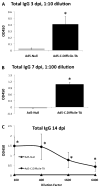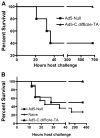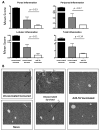Adenovirus-based vaccination against Clostridium difficile toxin A allows for rapid humoral immunity and complete protection from toxin A lethal challenge in mice
- PMID: 22200503
- PMCID: PMC4096697
- DOI: 10.1016/j.vaccine.2011.12.064
Adenovirus-based vaccination against Clostridium difficile toxin A allows for rapid humoral immunity and complete protection from toxin A lethal challenge in mice
Abstract
Clostridium difficile associated diarrhea (CDAD) is a critical public health problem worldwide with over 300,000 cases every year in the United States alone. Clearly, a potent vaccine preventing the morbidity and mortality caused by this detrimental pathogen is urgently required. However, vaccine efforts to combat C. difficile infections have been limited both in scope as well as to efficacy, as such there is not a vaccine approved for use against C. difficile to date. In this study, we have used a highly potent Adenovirus (Ad) based platform to create a vaccine against C. difficile. The Ad-based vaccine was able to generate rapid and robust humoral as well as cellular (T-cell) immune responses in mice that correlated with provision of 100% protection from lethal challenge with C. difficile toxin A. Most relevant to the clinical utility of this vaccine formulation was our result that toxin A specific IgGs were readily detected in plasma of Ad immunized mice as early as 3 days post vaccination. In addition, we found that several major immuno-dominant T cell epitopes were identified in toxin A, suggesting that the role of the cellular arm in protection from C. difficile infections may be more significant than previously appreciated. Therefore, our studies confirm that an Adenovirus based-C. difficile vaccine could be a promising candidate for prophylactic vaccination both for use in high risk patients and in high-risk environments.
Copyright © 2011 Elsevier Ltd. All rights reserved.
Conflict of interest statement
Figures








Similar articles
-
An optimized, synthetic DNA vaccine encoding the toxin A and toxin B receptor binding domains of Clostridium difficile induces protective antibody responses in vivo.Infect Immun. 2014 Oct;82(10):4080-91. doi: 10.1128/IAI.01950-14. Epub 2014 Jul 14. Infect Immun. 2014. PMID: 25024365 Free PMC article.
-
Systemic antibody responses induced by a two-component Clostridium difficile toxoid vaccine protect against C. difficile-associated disease in hamsters.J Med Microbiol. 2013 Sep;62(Pt 9):1394-1404. doi: 10.1099/jmm.0.056796-0. Epub 2013 Mar 21. J Med Microbiol. 2013. PMID: 23518659
-
A novel fusion protein containing the receptor binding domains of C. difficile toxin A and toxin B elicits protective immunity against lethal toxin and spore challenge in preclinical efficacy models.Vaccine. 2012 Jun 13;30(28):4249-58. doi: 10.1016/j.vaccine.2012.04.045. Epub 2012 Apr 23. Vaccine. 2012. PMID: 22537987
-
Clostridium difficile chimeric toxin receptor binding domain vaccine induced protection against different strains in active and passive challenge models.Vaccine. 2017 Jul 24;35(33):4079-4087. doi: 10.1016/j.vaccine.2017.06.062. Epub 2017 Jun 29. Vaccine. 2017. PMID: 28669616
-
Status of vaccine research and development for Clostridium difficile.Vaccine. 2019 Nov 28;37(50):7300-7306. doi: 10.1016/j.vaccine.2019.02.052. Epub 2019 Mar 19. Vaccine. 2019. PMID: 30902484 Review.
Cited by
-
A Replicating Single-Cycle Adenovirus Vaccine Effective against Clostridium difficile.Vaccines (Basel). 2020 Aug 22;8(3):470. doi: 10.3390/vaccines8030470. Vaccines (Basel). 2020. PMID: 32842679 Free PMC article.
-
Biochemical and Immunological Characterization of Truncated Fragments of the Receptor-Binding Domains of C. difficile Toxin A.PLoS One. 2015 Aug 13;10(8):e0135045. doi: 10.1371/journal.pone.0135045. eCollection 2015. PLoS One. 2015. PMID: 26271033 Free PMC article.
-
An optimized, synthetic DNA vaccine encoding the toxin A and toxin B receptor binding domains of Clostridium difficile induces protective antibody responses in vivo.Infect Immun. 2014 Oct;82(10):4080-91. doi: 10.1128/IAI.01950-14. Epub 2014 Jul 14. Infect Immun. 2014. PMID: 25024365 Free PMC article.
-
Vaccination against Clostridium difficile using toxin fragments: Observations and analysis in animal models.Gut Microbes. 2014 Mar-Apr;5(2):225-32. doi: 10.4161/gmic.27712. Epub 2014 Jan 22. Gut Microbes. 2014. PMID: 24637800 Free PMC article.
-
Vaccines against Clostridium difficile.Hum Vaccin Immunother. 2014;10(6):1466-77. doi: 10.4161/hv.28428. Epub 2014 Mar 17. Hum Vaccin Immunother. 2014. PMID: 24637887 Free PMC article. Review.
References
-
- Pechine S, Janoir C, Boureau H, Gleizes A, Tsapis N, Hoys S, et al. Diminished intestinal colonization by Clostridium difficile and immune response in mice after mucosal immunization with surface proteins of Clostridium difficile. Vaccine. 2007;25(May 20):3946–54. - PubMed
-
- Aslam S, Hamill RJ, Musher DM. Treatment of Clostridium difficile-associated disease: old therapies and new strategies. Lancet Infect Dis. 2005;5(September 9):549–57. - PubMed
Publication types
MeSH terms
Substances
Grants and funding
LinkOut - more resources
Full Text Sources
Other Literature Sources
Medical

